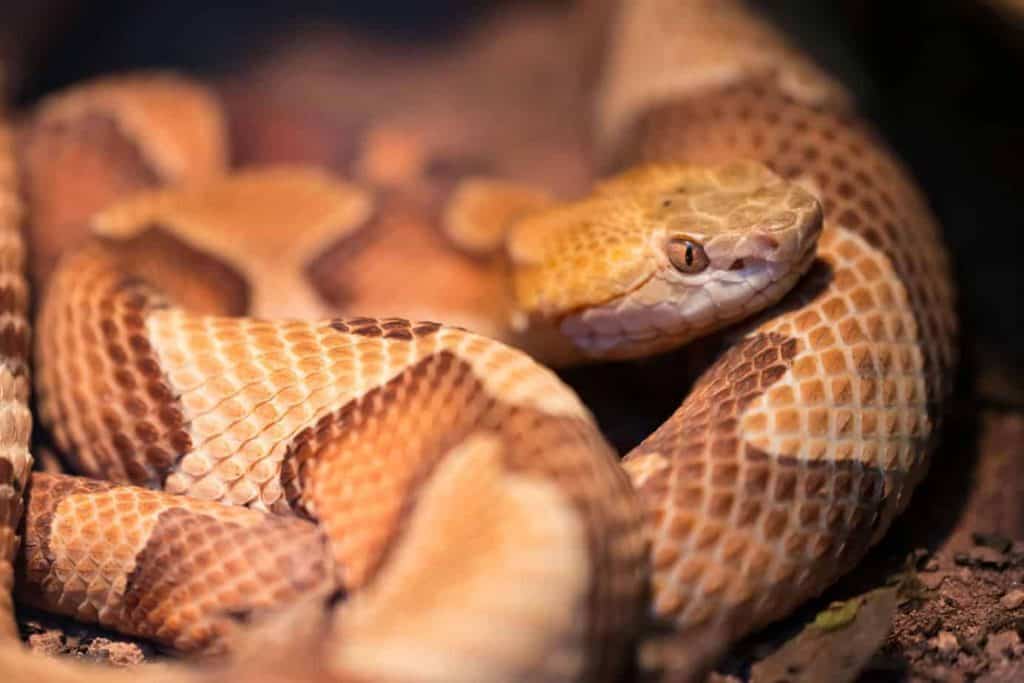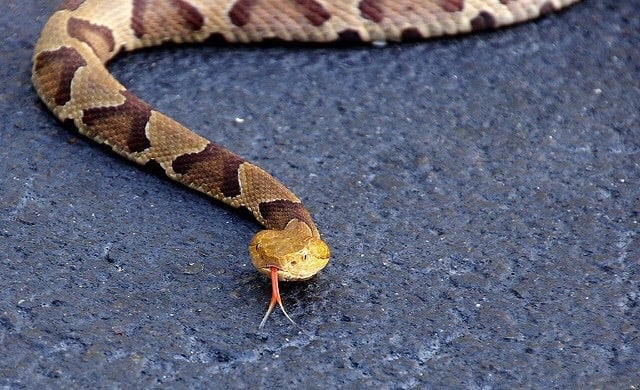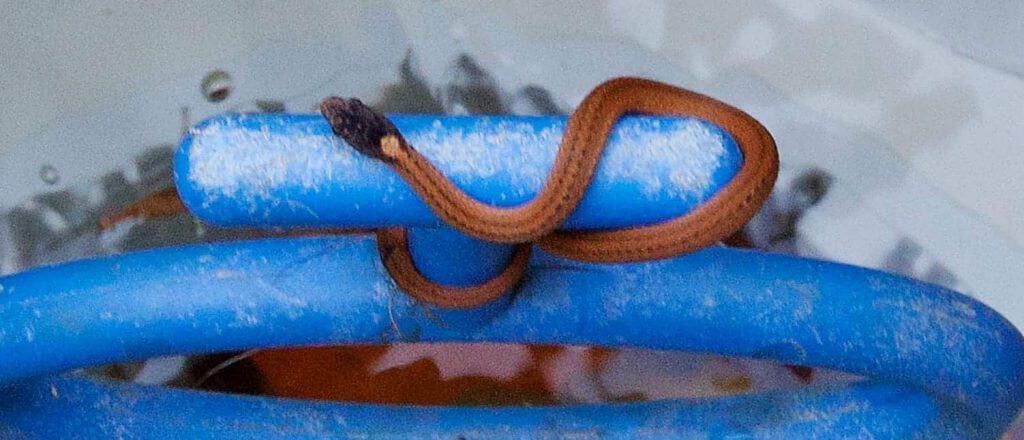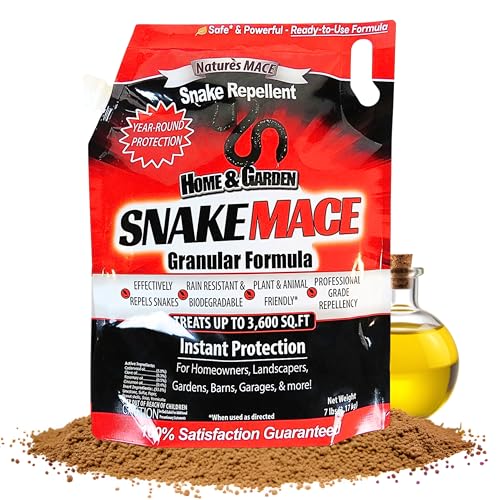Baby Copperhead Snake Identification Guide (Look for these 5 things!)
When you come across a snake in the wild, it can be hard to identify. Is it a sweet corn snake like your pet back home, or is it something more dangerous?
One of these snakes that is easy to confuse is the copperhead snake. When copperheads are young, they have some different appearances from the adults and other types of snakes, so let’s take a look at some of the identifiers of baby copperheads.
What Do Baby Copperhead Snakes Look Like?
What do baby copperhead snakes look like? Baby copperheads look almost the same as adult copperheads in pattern and
5 Things To Look for in Identifying a Baby Copperhead
- The most obvious way of identifying a copperhead is
shape of the dark splotch pattern running horizontally on the body. The shapes are wider on the sides of the snake and skinner at the top–forming anhour glass pattern. - Does it have a bright yellow-tipped tail? Adult copperheads do not have this coloring, but babies often (but not always) do.
- Is the head a reddish/coppery color? This is the usual color of a copperhead (hence the name).
- Are there two dark spots on the top of the head? Not all baby copperheads have this, but many do.
- Check that the blotch pattern extends all the way to the sides of the snake. This is how you can tell it apart from a
rattlestnake , which has smaller blotches not extending all the way down the sides.
Copperhead snakes are poisonous, so they are not snakes you should consider keeping as a pet. Be sure you know how to recognize a copperhead in case you or your child come across one in the wild and want to take it home as a pet.

Baby Copperhead Coloring
Baby copperheads look very similar to adult copperheads. Copperheads are so named because their heads are a reddish, coppery color. This is one of their most, identifiers.
Both adult and baby copperheads display this feature. They also typically have two small, dark spots on the top of their heads, though some may not have the spots. Other than the dots, there is no pattern on the heads of copperhead snakes.
The body of a copperhead is usually a light tan or slightly pink color. Sometimes baby copperheads are grayer than adults, but turn the more brownish color as they age. Along the back of the snake are dark brown or reddish-brown markings.
Several other types of snakes have similar coloring, but the copperhead is distinctive because of the markings, which look like hourglasses. The coloring of a copperhead helps it blend in with bushes or fallen leaves. They are very good at hiding, so keep an eye out for them if they are native to your area.
The belly of the copperhead is usually lighter than the rest of the body, and it often has a rough or patchy look to it. Sometimes there are also dark smudge-like markings along the sides of the belly.
Baby copperheads do have one feature that makes them stand out from adult copperheads. They have a bright yellow tail that they can use to help trick prey into coming near.
The baby wiggles its yellow tail to make small creatures think it is a worm. Once the prey is near enough, the baby attacks it. As copperheads age, the yellow colored tail fades to a color closer to the color of the rest of the body.
Other Identifiers
Several other features distinguish baby copperheads from other snakes. The head of a copperhead is wedge-shaped and may look a little heart-shaped when viewed from above. Some snakes would have narrower or rounder heads, so the snake’s head shape can be a good indicator.
Copperheads are also pit vipers, which means they hunt with the help of two slits between the eyes and nostrils. These slits aid the snake in sensing thermal radiation.
If there is even a slight change in the heat near the snake, it will know. The copperhead uses this feature to learn how close their prey is. Copperheads are not the only pit vipers, so they aren’t the only ones with this feature. Other snakes that qualify as pit vipers include rattlesnakes and water moccasins.
Another feature to pay attention to are the eyes of the snake. Copperheads have elliptical yellow eyes, which means that their pupils are slits not circles, like a cat’s eyes.
Baby copperheads are about 8-10 inches long when they are born. This is pretty small, so some people may not recognize them as dangerous at first.
But a copperhead is still a copperhead, so be careful no matter what the snake looks like. After a baby copperhead reaches adulthood, it will be somewhere between 2-3 feet long.
Are Baby Copperhead Snakes Poisonous?
Yes, baby copperheads are poisonous, just like adult copperheads. Copperhead babies are born live, not hatched from eggs, and when they are born, they already have fangs and venom.
Even if a baby is only a day or two old, it is still dangerous and may still attack if threatened. If bitten, the bite could become infected and painful from the venom, though a baby is likely to release less venom than an adult copperhead.
The babies also use their venom for hunting. Their yellow tails help lure the prey, but the venom from the bite of the snake is what kills the prey.

Other Snakes That Resemble the Copperhead
Though copperhead snakes have several distinctive features, there are other types of snakes that look similar to them.
Some of the snakes listed here are safe to have as pets and some are not, so be extremely careful with the identification of these creatures.
- Corn snakes – Corn snakes actually can make a good pet. These snakes have a similar reddish brown color to copperheads, so at first look, they may be easy to mix up. However, though corn snakes do have markings on their backs, the markings are not hourglass-shaped.
- Northern water snakes – These snakes have very similar coloring and size to copperheads. One of the biggest differences between these two species is the head shape. Northern water snakes have narrower heads that are not distinctive in shape from the rest of their bodies, while the copperhead has the wedge-shaped head of a pit viper.
- Eastern hognose snakes – This snake species comes in a variety of colors, so some of them end up looking like copperheads, even like young copperheads sometimes. However, the eyes, head shape, and pattern will all be different from the copperhead.
- Black racer snakes – These will likely only be confused with copperheads when they are young. As adults, they will turn almost completely black but may have patterns when young. The head shape is a strong difference between these two species, and the eye color of a racer is black.
- Mole kingsnakes – These are also similar in coloring, mostly when young, to copperheads, but the markings are narrow rather than hourglass shaped. The head of the mole kingsnake is much smaller than that of a copperhead, and they have small black eyes.
In general, if you want to distinguish whether or not a snake is a copperhead, the top things to pay attention to are the hourglass-shaped markings, the head shape, and the elliptical eyes.
These will be the most helpful to you when identifying the copperhead.
Here is a link that discusses the differences between these snakes and others in more detail.
Snake Repellent Solutions
Related Questions
Is a baby snake more poisonous than an adult snake? In general, no. A baby snake is not likely to be more poisonous than an adult snake.
Some may say that a baby would be more dangerous because it doesn’t know how to control the amount of venom it releases, but this idea is unverified.
Can a copperhead kill you? Copperhead venom could be deadly, but usually, the snake doesn’t inject enough venom to kill a human.
They don’t see humans as prey, so they want to deter the human so they can escape, but they aren’t too concerned with killing the human.
However, copperhead venom is dangerous and if you are bitten, you should seek medical attention.
What are some more names for a copperhead snake? A copperhead snake might be confused with the following: water moccasins, cottonmouths, radiated snakes, “Australian copperheads”, and sharp-nosed pit snakes.
These are different from North American copperhead snaked. Their scientific name is the Agkistrodon contortrix.



